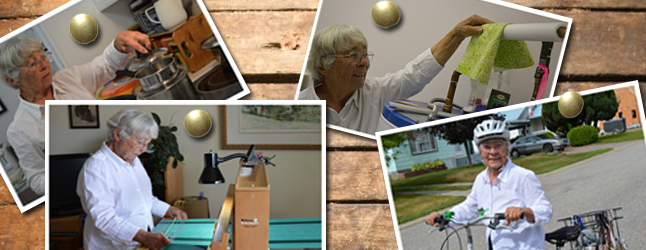
This summer I have gone off the electrical grid and am living almost fossil fuel free (I have allowed myself a fossil fuel budget of two car rides return a month). My electricity comes from the sun, I cook with the sun and I walk or bicycle to get around.
This series of articles discusses some of my adventures. Today’s article focuses on Inge Anhorn, whose daily practice of conserving and thinking about energy and water use never fails to inspire me. You can also follow my blog at http://myoffthegridsummer.blogspot.ca/
By Laura Stovel
Very few people in Revelstoke have thought more about energy conservation than Inge Anhorn. Anhorn, who will be 80 in December, is known for gliding down the streets of Revelstoke on her signature folding bicycle and for selling hand-woven and knitted items at the farmer’s market.
Over the years, Anhorn has collected some thoughtful tips for conserving energy – or rather, avoiding waste. When she cooks something on the stove, she covers the pot with a glass pot lid, placed upside down. On that lid, she places a smaller pot, covered with a lid.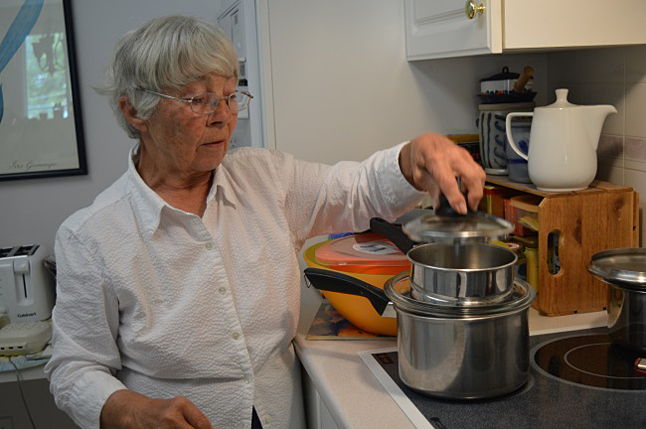
The second pot may contain butter that she needs to melt, a sauce or other food that she needs to heat up. The heat from the first pot, which would have just gone into the air, is then doing double service. (Extra pot lids can be found at the thrift store).
Anhorn also turns off the heat on the stove a few minutes early, letting the food sit to cook the extra amount over the cooling element.
When Anhorn sees waste heat, she sees an opportunity to do something with it. Although she has insulated the pipes of the water heater in her laundry room, heat still escapes so she hangs small things like rags and wash cloths on them. That is also a good place to dry cloth bags that she has washed.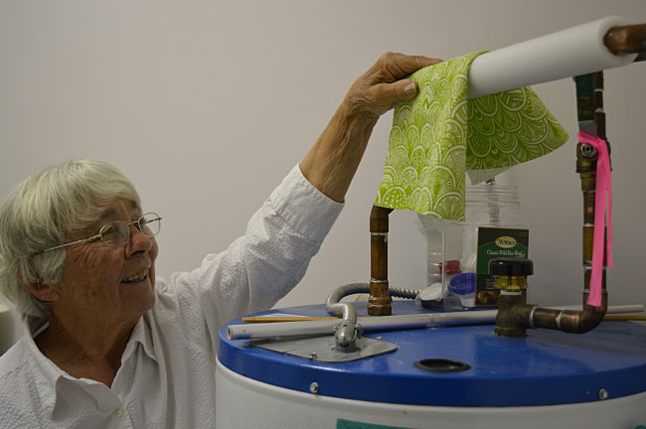
She air-dries all her laundry on a wooden rack. “I can use the sun or the little bit of heat that’s around to dry my clothes,” she said. “I don’t know what it costs to use a drier. Maybe $1 a load. In my case that would be two loads a week. That is eight loads. That might amount to $10 a month and $120 a year. That’s a lot of money for someone on a pension or even on smaller incomes.”
Another energy-saving strategy came from Nicoline Beglinger, co-owner of Selkirk Mountain Experience, a back-country skiing company based near the remote Durrand Glacier. As Anhorn explained, fuel has to be helicoptered in to the chalet at great expense so to conserve energy Nicoline would fill kettles and pots with water at night and let it warm to room temperature. By morning the water would be a few degrees warmer and that meant using less fuel to heat it.
Being organized also makes a difference in conserving energy, Anhorn said. Before she opens the fridge door she thinks about all the things she needs to take out and before she returns items to the fridge she assembles them all on the counter. “That way I only need to open the fridge door once.”
Anhorn still has her driver’s license but she gave up her car eight years ago when it became too expensive to maintain. “Why pay for a car when it just sits there most of the time and I can go with my feet or my bike? It’s a little awkward not to have a car because I can’t go on the spur of the moment to Vernon or take a drive” but generally Anhorn enjoys the exercise of walking and biking.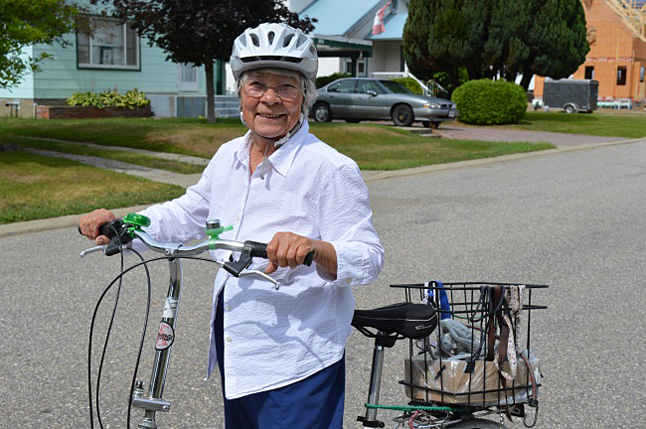
Anhorn’s concern about conservation and avoiding waste dates back to her childhood in Germany during the Second World War. Water was metered and the family went to great lengths to avoid wasting it.
“Every drop counted because it cost money,” she said. “My family tried to preserve it and get as much use out of water as we could. That meant making the water work double or three times.
“Our clothes were washed by hand and boiled, not in a machine. That meant the clothes were washed in soapy water, rinsed, rinsed, rinsed (in separate buckets), until it was all clean. The soapy water was used to clean toilets or wash floors. The next water was used to water plants or wash the stairwells in the building. The next water was stored until you used it all up. That was a very big thing. That made a big impression on me. Even today I still use that idea.”
As a child, Anhorn remembers hauling water from a standpipe for the community garden and for her grandfather’s bee-keeping house. They weren’t allowed to run around with it or spray it.
“That was totally unheard of,” she said. “It’s nice for children (to play with water) but in my mind people should respect water a little bit more than they do.”
“One drop of water is nothing. If a family saves 100 drops and you multiply that by 30,000 Canadians, that’s a lot of drops. That’s how I look at it.”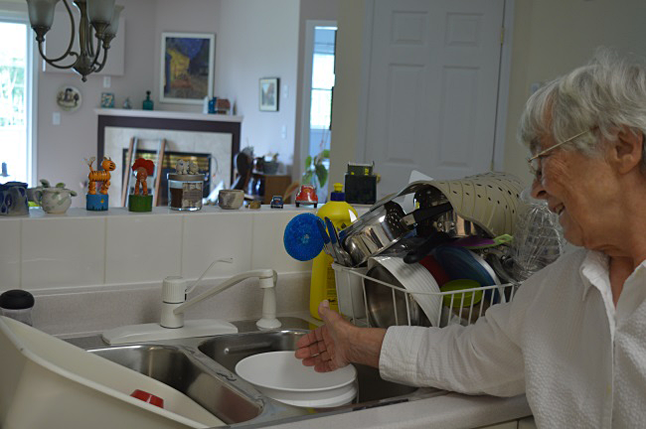
Even in Revelstoke where water is relatively plentiful, when Anhorn runs water to make it hot, she takes a bucket to collect the cold water and uses it later to wash her hands or water plants.
For Anhorn, “You don’t need to use resources just because they’re handy. With a little bit of extra effort you can do without. Even if I made $100,000 a year, it doesn’t mean I need to spend a resource when I can do without it. That’s my philosophy. It might not mean much to other people but to me it’s a practice that I like to do.”
With her emphasis on conservation, I thought that Anhorn might be a person who saves things just in case they might be useful one day. That couldn’t be farther from the truth. Anhorn’s apartment is free of clutter. It is fresh and light with lots of open space.
“I don’t save things that I don’t use. Let someone else use it,” she said. She saves a few jars and a few yogurt containers to store food but the rest goes to recycling – or if they’re usable, to the thrift shop. “I don’t want clutter because I don’t want my children to go through a nightmare.”
Also, things get old, she said. “You have something in your house sitting there for 20 years. By the time you leave this world the stuff is too old for the thrift shop. What happens? It gets thrown out. It’s better to give it away while it’s still useful to other people. They can still make a buck on it and your house is clean.”
As a final piece of advice, Anhorn stresses that time is precious so it should be used purposefully. “I don’t want to waste my time in a way that doesn’t interest me. I want to do things that are important to me and that’s why I want to use my time in a positive way.”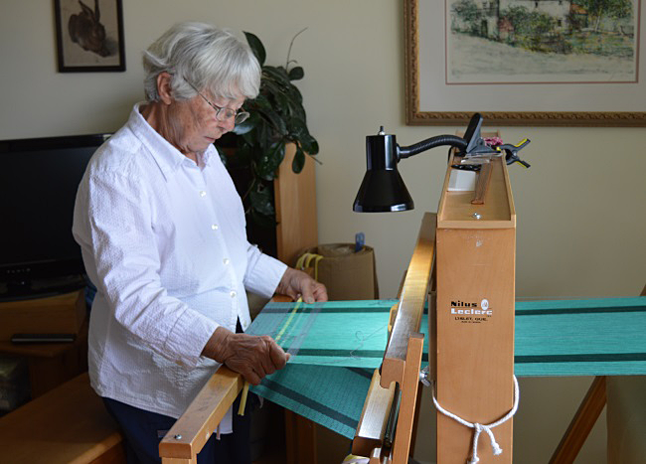
Westerners have become used to living as if resources are plentiful. As we adapt to new realities brought on by the threat and realities of climate change, designers and engineers are striving to develop more efficient technologies that maintain our lifestyles while relying less on fossil fuels and other non-renewable energy.
The other side of the equation is the practice of consuming and wasting less. As Anhorn’s habits and my off-the-grid project try to show, simple adjustments can lead to less energy waste and that can only be good for the planet and for future generations.



